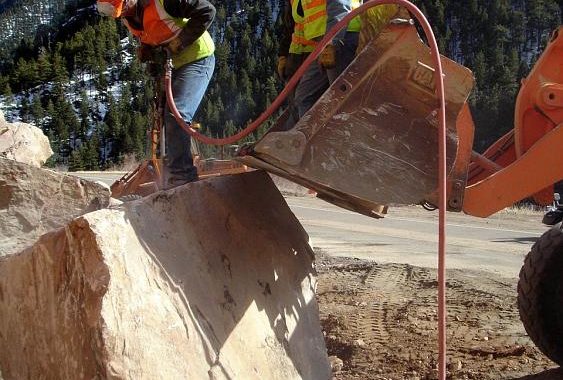Front End Loaders (Download)
Front End Loaders What is a Front End Loader? A Front End Loader is a type of tractor, usually wheeled, sometimes on tracks, that has a front mounted bucket connected to the end of two arms to scoop loose debris or material such as dirt, sand or gravel. The loader then moves the material and deposits it in another location. A loader is commonly used to move stockpiled material and depositing it into an awaiting dump truck, a storage pile or into a open trench. Front End Loader Operation Front End Loaders are operated from the cab by an equipment operator Safety Concerns The main safety hazards associated with the use of Front-End Loaders are: Bystanders being struck by the bucket or other part of the machine Pedestrians being run over by the loader Workers being caught in/between the loader and a stationary object Rollover (working on sloping ground) Struck By Loader or bucket can strike a person . Material can also fall out of bucket and strike someone. Run Over A distracted worker or pedestrian can be run over by a loader Caught In Between Workers could be caught in between loader and other equipment or materials. Workers can also be caught in/between the moving parts of the loader, especially if it is an articulating loader People could get caught between the loader and something else because they are not seen or because of equipment failure During mechanical repair, the arms can lose hydraulic pressure and crush the mechanics working on them Brakes can fail and the loader could roll until it hits an object in its way Rollover While in motion or stopped the loader can rollover, especially on steep grades or when being loaded or unloaded from a lowboy. Rollovers occur when the loader either becomes unbalanced or the ground gives way OSHA Fatalities 81 fatalities involving Front-End Loaders were investigated by OSHA from 1990 thru 2009 82% of the fatalities were people (usually workers) other than the loader operator 18% of the fatalities pertained to the death of the loader operator Source: Extracted from 1990-2009 OSHA Fatality Data OSHA Fatalities Continued Run over 20 Caught in between 18 Struck by 13 Rollover 10 Mechanical failure 08 Person in bucket 07 Thrown from 02 Dump mat’l on worker in trench 01 Swept away 01 Fell down 01 Source: Extracted from 1990-2009 OSHA Fatality Data OSHA Regulations Must have seat belts unless vehicle has no Rollover Protective Structure Must have access roadways and grades that allow for safe use of loaders Must have brakes capable of stopping fully loaded machine Must have a horn with distinguishable noise Must have guards over scissor points Source: Obtained from OSHA 1926. 602 Best Practices PPE for loader operators: Hard hat Safety shoes Safety goggles Heavy gloves Reflector vests (as needed) Hearing protection Respirators (as needed) Walk around the loader to check for people or materials (check the immediate area and the path of travel) Become familiar with the work area: Slopes Direction of travel Traffic Holes and obstructions Conditions of roads Location of buried utilities Best Practices Take time to read operators manual before using loader Before operating, check to be sure the major systems are functioning Check to make sure the safety equipment on the loader is intact Best Practices When entering the cab, have three points of contact Face the loader when mounting and dismounting Warn personnel in area before starting loader Always wear seatbelt and safety equipment as designated by the jobsite safety practices Beware of workers standing/working nearby Best Practices Best Practices Bucket for Loader must be lowered while in motion Make sure when scooping or dumping that nobody is in danger of being struck by the bucket or materials being dumped Best Practices Drive slowly and cautiously Be aware of the ground conditions and slope Best Practices Do not drive loader near anybody at high speeds, and make sure nobody is coming toward loader from a blind corner Once started, conduct operations and control check Keep work area as flat and level as possible When traveling, be aware of vision being obstructed Move and turn loader at low speeds Adjust speed of machine based on site conditions Stay in gear when traveling downhill Carry loader bucket at a low position during travel Best Practices Be aware of grade when backfilling. Never undercut a high bank. When traveling with a loaded bucket on a slope, point bucket toward the higher grade. When bucket is empty, angle bucket toward the lower grade Make sure not to lift the bucket higher than recommended Do not permit anyone to stand under a raised loader bucket Never approach power lines with a raised loader bucket Best Practices Never allow workers in the loader bucket Do not park on slopes Do not park on overhaul roads (pull off to the side) Lower bucket, stop engine, and lock brakes before exiting the loader Best Practices Think Safety Work safely

